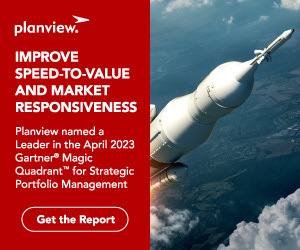
Dynamic planning has taken on new depths of meaning recently as we react to unprecedented developments on a daily and even hourly basis. At Planview, we get it: You are being forced to make quick decisions that could have long-lasting consequences for your employees, customers, and shareholders. You must apply the agility and flexibility you’ve cultivated as an organization to the most momentous of considerations, such as scaling back spending, shifting priorities, and realigning your workforce.
This blog is the first in a series about how to better understand the short- and long-term impact of decisions and adapt as conditions change. Portfolio management provides the foundation from which to make these decisions based on data, not knee-jerk reactions or best guesses.
To understand the potential domino effects of various options requires the right information and ability to model different scenarios. As your organization starts making these decisions, you’ll need to continuously evaluate status and do rapid reprioritization. This is what dynamic planning is all about, providing the dexterity to quickly shift while still keeping resources aligned and mapped to your strategic goals at all times.
Here’s a look at how organizations are showing dexterity in today’s changing environment and times of uncertainty.
Fortune CEO Alan Murray met virtually (and confidentially) with 40 chief executives this week and was struck by their innovation during this crisis. For instance, novel digital methods of communicating and “nurturing community” are emerging from new dynamics such as large remote workforces. They are not seeking perfection but embracing the fail-fast mentality that creates even more innovation. As we make it through this difficult time, their advice is to approach recovery not as a “great restart,” but a “great reset.”
Ford, 3M and GE are partnering to manufacture medical supplies such as ventilators, face shields, and respirators. According to The Washington Post, these companies are “…repurposing existing parts and hundreds of workers in a wartime-like battle against the outbreak.” While the respirators and ventilators may take longer to deliver, Ford “pivoted quickly” to produce 3D-printed face shields, delivering 1,000 to Detroit hospitals for testing just last week.
A few weeks ago, Austin’s Tito’s Handmade Vodka was warning people not to use its vodka as hand sanitizer. Now, under the direction of founder Tito Beveridge (yes, correct name and spelling!), they are working feverishly to produce 24 tons over the next several weeks and more when needed.
Roche and Thermo Fisher Scientific marshalled their respective emergency response teams to develop the first commercial tests for COVID-19. The FDA authorized these tests for “Emergency Use” in mid-March. Roche said that it’s also “…actively involved in understanding the potential of our existing portfolio.” Thermo Fisher has already shipped tests to about 200 labs across the country and plans to produce up to five million tests a week in April 2020.
The key is to have adaptive portfolio management capabilities in place that facilitate dynamic planning and rapid reprioritization.
These shifts and actions underscore the complexities of adjusting vast resources and reconfiguring operations to survive and thrive long after a disruption passes. The key is to have adaptive portfolio management capabilities in place that facilitate dynamic planning and rapid reprioritization. To make these pivots, you must have accurate data and insights that tie into a bigger picture you can see and manage across portfolios.
You must understand, among other factors:
- Projects that are currently underway and the status of each
- Projects that can be put on hold or cancelled based on financial and strategic impact
- Projects your people are currently working on
- The available skills and expertise across the globe to take on new types of work
- Where and how to shift employees to other projects
Making the right decisions requires using scenarios to model the impact of potential changes, balance trade-offs, and visualize the reallocation of resources and funding. You must be able to plan, analyze, and prioritize investments in the context of your entire portfolio. Dynamic planning processes are integrated and continuous, enabling you to adjust and react to new information.
Planview customers are using these capabilities in our portfolio and work management solutions to reprioritize and align their now virtual teams to ensure on-strategy delivery. We remain committed to helping these customers on their transformation journeys to become more agile and make effective decisions in support of strategy. Many are highly sophisticated in their approach to dynamic planning and rapid reprioritization.
For example, a major energy company is using Planview’s what-if scenario planning to review all internal projects around the world and determine which to suspend for now and which to fast-track. This long-time customer has the data and analyses already in Planview to make these difficult decisions across their global portfolios quickly. They can factor in financial and resource constraints to rapidly reprioritize initiatives around the company strategy.
A manufacturing customer is reprioritizing its $3 billion capital portfolio using Planview’s investment planning capabilities. Given shifts in financials, resources, and risk, the company can balance its portfolio across growth, innovation, digital transformation, and keep-the-lights-on enterprise-wide initiatives. Also, one of our partners is helping an Asian transportation authority to effectively postpone a number of capital projects. Using critical information and analysis with Planview’s solutions, they can safely move people and equipment around and optimize their budget.
Learn more by reading the other blogs in this series:
Part 2: Dynamic Planning: Refocus, Reprioritize, and Reallocate Rapidly
Part 3: Rapid Reprioritization: Delivering on Strategy in the Midst of Change
As you are weighing alternatives that you never thought possible just a few weeks ago, know that Planview is here help you make informed, data-backed recommendations. That’s what we’ll cover in our next blog post in this series.
To get a head start on dynamic planning and rapid reprioritization of your program, project, and product portfolios, learn more about Planview’s Strategic Planning solution here: https://www.planview.com/products-solutions/solutions/strategic-planning/






